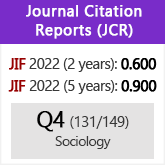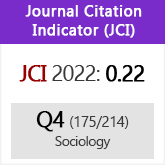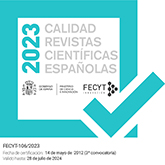The contribution of sexual difference feminism to the analyses of gender within sport
DOI:
https://doi.org/10.3989/ris.2006.i44.30Keywords:
Female Sexual Difference, Gender, Women’s Relationships, RugbyAbstract
In this article, the author explores how sexual difference feminism can contribute to the analyses of women’s experiences in rugby. The author uses the most important concepts of sexual difference feminism like affidamento relationships, female authority and female desire and freedom to show the need to create a new language that allows thinking and interpreting female rugby experiences. A feminine rugby practice which is framed beyond traditional gender stereotypes of sport. The paper ends concluding the importance of creating a new symbolic order in which women can make sense of their way of being and thinking in and of sport.
Downloads
References
Birrell, S. (2000), “Feminist theories for sport”, en J. Coakley, E. Dunning (eds.), Handbook of sport studies, Londres, Sage, pp. 61-76.
Blasco, P. (2005), Siempre adelante. Mujeres deportistas, Madrid, Instituto de la Mujer.
Bocchetti, A. (1996), Lo que quiere una mujer, Madrid, Cátedra.
Braidotti, R. (1997), “Sexual difference theory”, en A.M. Jaggar y I.M. Young (eds.), A companion to feminist philosophy, Oxford, Blackwell, pp. 298-306.
Broad, K. L. (2001), “The gendered unapologetic: Queer resistance in women’s sport”, Sociology of Sport Journal, vol. 18, pp. 181-205.
Carle, A. y J. Nauright (1999), “Crossing the line: Women playing rugby union”, en S. Chandler y J. NAURIGHT (eds.), Making the rugby world, Londres, Frank Cass, pp.128-148.
Caudwell, J. (2003), “Sporting gender: Women’s Footballing Bodies as Sites/Sights for the (Re)Articulation of Sex, Gender and Desire”, Sociology of Sport Journal, nº 22, pp. 371 – 386.
Caudwell, J. (1999), “Women’s football in the United Kingdom: Theorizing gender and unpacking the butch lesbian image”, Journal of Sport and Social Issues, vol. 4, pp. 390-402. doi:10.1177/0193723599234003
Cavarero, A. (1993), “Towards a theory of sexual difference”, en S. Kemp y P. Bono (eds.), The lonely mirror, Londres, Routledge, pp.189-221.
Cigarini, L. (1996), La política del deseo, Barcelona, Icaria.
Cox, B. y S. Thompson (2000), “Multiple bodies”, International Review for the Sociology of Sport, vol. 35, pp. 5-20. doi:10.1177/101269000035001001
Hall, A. (1996), Feminism and Sporting Bodies, “Essays on theory and practice”, Champaign, IL, Human Kinetics, Publishers.
Hargreaves, J. (1994), Sporting Female, Londres, Routledge.
Irigaray, L. (1985a), Speculum of the other woman, Ithaca, Cornell University Press. [1974]
Irigaray, L. (1985b), This sex which is not one, Ithaca, Cornell University Press.[1977]
Irigaray, L. (1993), Sexes and Genealogies, Nueva York, Columbia University Press.
Kemp, S. y P. Bono (1993), “Introduction. Without a leg to stand on”, S. Kemp y P. Bono (Eds.), The lonely mirror, Londres, Routledge, pp. 1-28.
Krane, V. (2001), “We can be athletic and feminine, but do we want to? Challenging hegemonic femininity in women’s sport”, Quest, vol. 53, pp. 115-133.
Librería de Mujeres de Milán (1991), No creas tener derechos, Madrid, Horas y horas.
Lledó, E. (2005), De llengua, diferència i context, Barcelona, Institut Català de la Dona.
Markula, P. (2003), “The technologies of the self: Sport, feminism and Foucault”, Sociology of Sport Journal, vol. 20, pp. 87-107.
Menesson, C. y J.P. Clement (2003), “Homosociability and homosexuality: the case of soccer played by women”, International Review for the Sociology of Sport, vol. 38, pp. 311-330. doi:10.1177/10126902030383004
Muraro, L. (1991), “Bonding and freedom”, en Bono P.; Kemp S. (eds.), Italian feminist thought (pp. 123-126), Oxford, Blackwell.
Muraro, L. (1994), El orden Simbólico de la madre, Madrid, Horas y horas.
Muraro, L. (2002), “The passion of feminine difference beyond equality”, en Parati, G. y R. West (eds.), Italian Feminist Theory and Practice. Equality and Sexual Difference, Londres, Associated University Presses, pp. 77-87.
Muraro, L. (2004), “Enseñar la libertad”, Duoda, nº 26, pp. 77-83.
Piussi, A. M. (1999), “La diferencia sexual, más allá de la igualdad”, Cuadernos de Pedagogía, nº 267, pp. 10-16.
Rivera, M. (1994), Nombrar el mundo en femenino, Barcelona, Icaria.
Rivera, M. (1997), El fraude de la igualdad, Barcelona, Planeta.
Scraton, S., G. Pfister, K. Fasting y A. Buñuel(1999), “It’s still a man’s game? The experiences of toplevel European women footballers”, International Review for the Sociology of Sport, vol. 34, pp. 99-111. doi:10.1177/101269099034002001
Seidman, S. (1994), Contested knowledge: Social theory in postmodern era, Cambridge, Basil Blackwell.
Theberge, N. (2000), “Gender and Sport”, en J. Coakley y E. Dunning (eds.), Handbook of sport studies, Londres, Sage.
Wesely, J.K. (2001), “Negotiating gender: Bodybuilding and the natural/unnatural continuum”, Sociology of Sport Journal, vol. 18, pp. 162-180.
Wedgwood, N. (2004), “Kicking like a boy: Schoolgirl Australian rules football and bi-gendered female embodiment”, Sociology of Sport Journal, vol. 21, pp. 140-162.
Weedon, C. (1987), Feminist practice and poststructuralist theory, Oxford, Basil Blackwell.
Wright, J. y G. Clarke (1999), “Sport, the media and the construction of compulsory Heterosexuality”, International Review for the Sociology of Sport, vol. 34, pp. 227-243. doi:10.1177/101269099034003001
Downloads
Published
How to Cite
Issue
Section
License
Copyright (c) 2006 Consejo Superior de Investigaciones Científicas (CSIC)

This work is licensed under a Creative Commons Attribution 4.0 International License.
© CSIC. Manuscripts published in both the printed and online versions of this Journal are the property of Consejo Superior de Investigaciones Científicas, and quoting this source is a requirement for any partial or full reproduction.All contents of this electronic edition, except where otherwise noted, are distributed under a “Creative Commons Attribution 4.0 International” (CC BY 4.0) License. You may read here the basic information and the legal text of the license. The indication of the CC BY 4.0 License must be expressly stated in this way when necessary.
Self-archiving in repositories, personal webpages or similar, of any version other than the published by the Editor, is not allowed.

















